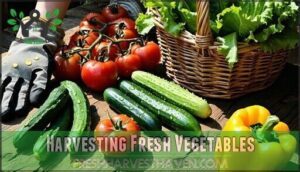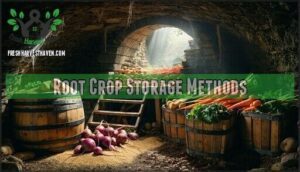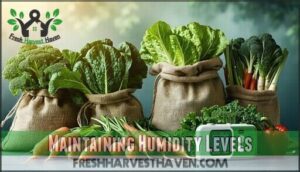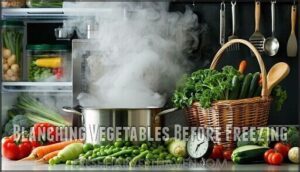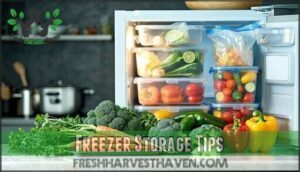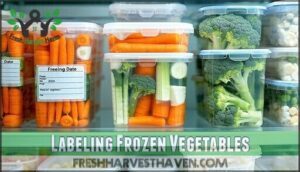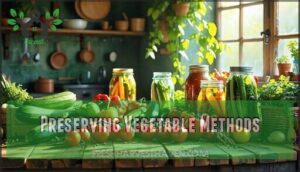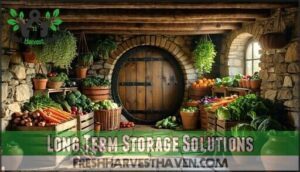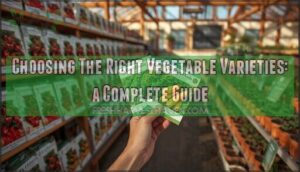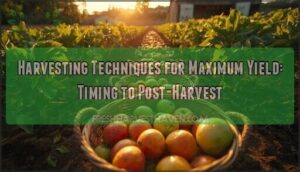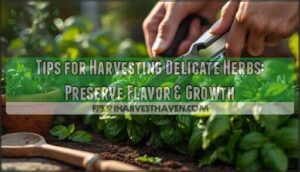This site is supported by our readers. We may earn a commission, at no cost to you, if you purchase through links.
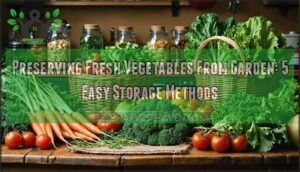
Harvest vegetables at peak ripeness during cool morning hours, then store root crops in cool, humid conditions while refrigerating leafy greens promptly.
Blanch vegetables before freezing to maintain color and nutrients, or dry herbs and tomatoes for concentrated flavors.
Canning and pickling transform surplus produce into shelf-stable treasures that’ll last months.
Each method requires specific temperature and humidity controls, but the payoff is tremendous—you’ll enjoy your homegrown vegetables year-round while reducing waste and saving money on groceries, which is a significant benefit of reducing waste and using these preservation methods to have a year-round supply.
Table Of Contents
- Key Takeaways
- Harvesting Fresh Vegetables
- Storing Vegetables Safely
- Freezing Fresh Vegetables
- Preserving Vegetable Methods
- Long Term Storage Solutions
- Frequently Asked Questions (FAQs)
- What is the best way to preserve garden vegetables?
- How do you store all fresh vegetables for a longer period of time?
- What are the five methods of preservation of vegetables?
- How to store fresh vegetables from the garden long-term?
- How to preserve veggies from the garden?
- What is the best way to preserve raw vegetables?
- How do you preserve vegetables?
- How to keep garden vegetables?
- How to preserve vegetables for winter?
- Is summer a good time to preserve vegetables?
- Conclusion
Key Takeaways
- Master proper harvesting timing – You’ll get the best results by harvesting vegetables at peak ripeness during cool morning hours when they’re firm and vibrant, then handling them gently to prevent bruising that reduces storage life.
- Choose the right preservation method for each vegetable – You can freeze most vegetables after blanching them for 1-3 minutes, use pressure canning for low-acid varieties like green beans and corn, or dry herbs and tomatoes for concentrated flavors.
- Control temperature and humidity for maximum freshness – You’ll extend storage life by maintaining 32-40°F temperatures with proper humidity levels, using root cellars for hardy crops and refrigerator crisper drawers with perforated bags for leafy greens.
- Diversify your preservation techniques to reduce waste – You’ll maximize your harvest’s value by combining multiple methods like freezing, canning, drying, and fermentation, which lets you enjoy homegrown vegetables year-round while saving money on groceries.
Harvesting Fresh Vegetables
You’ll want to harvest your vegetables at their peak ripeness when they’re firm, vibrant in color, and free from blemishes or soft spots.
Handle them gently during harvest to avoid bruising, which can lead to faster spoilage and reduced storage life.
Handling Vegetables Minimally
Every successful vegetable preserving fresh vegetables journey starts with gentle handling during harvest.
Your produce deserves minimal processing to prevent bruising, water damage, and early spoilage that ruins storage efforts.
Essential damage control practices include:
- Sort immediately to remove damaged vegetables before storage
- Wash sparingly using cool water, avoiding oversaturation
- Handle gently like you’re cradling eggs, not tossing rocks
- Process quickly to maintain peak freshness and nutritional value
Harvesting High-Quality Produce
Quality starts with crop selection and proper produce handling during harvest season.
You’ll want sharp, clean tools to make precise cuts that prevent disease spread and damage to your garden vegetables.
Harvest timing matters—pick vegetables at peak ripeness when they’re firm, vibrant, and free from blemishes.
Skip wet days since moisture promotes rot and reduces storage life.
Focus on selecting quality vegetables by inspecting each piece for signs of disease, insect damage, or overripeness.
This careful approach to preserving fresh vegetables begins with your vegetable harvesting guide strategy in the field.
Ideal Harvesting Time
Perfect timing separates good garden vegetables from great ones.
You’ll maximize flavor and nutrition by monitoring ripening signs and following harvest schedules for each crop.
Carrots actually sweeten after frost, while beans need frequent picking at peak ripeness.
Seasonal timing matters—tomatoes love summer heat, but root crops thrive in cold.
Regular maturity checks guarantee your preserving garden harvest starts with the highest quality produce possible.
Storing Vegetables Safely
You’ll keep your freshly harvested vegetables at their peak quality by storing them in the right conditions immediately after picking.
Proper storage methods protect your garden’s bounty from spoilage, extending freshness from days to several months depending on the vegetable type and storage technique you choose, which helps maintain the vegetables’ quality by using the right conditions for proper storage.
Root Crop Storage Methods
For serious gardeners, root cellar storage transforms your harvest into year-round sustenance.
Root cellars maintain ideal conditions at 32-38°F with 90-95% humidity control, preventing spoilage that claims up to 15% of stored crops annually.
**Root cellars slash spoilage by 85% while maintaining perfect storage conditions naturally.
Winter storage success depends on proper ventilation and cool dry locations that mimic nature’s refrigeration system.
Essential root vegetable storage requirements include:
- Temperature monitoring – Keep soil temperature consistent between 1-4°C using insulated containers
- Humidity control – Layer crops in sand or sawdust to maintain moisture without waterlogging
- Crop rotation – Inspect stored vegetables every 2-3 weeks, removing damaged ones first
- Ventilation planning – Guarantee air circulation prevents ethylene gas buildup that accelerates sprouting
These vegetable storage methods extend freshness for months, making cellar storage your most reliable preservation technique.
Effective root cellar kits can help achieve prime storage conditions for your harvest.
Refrigeration Best Practices
How can you maximize your vegetable fresh keeping potential through proper refrigerator storage?
Set your refrigerator between 32°F and 40°F for ideal chill management.
Use your crisper drawer with perforated bags for humidity control.
This cold storage approach extends shelf life substantially.
Proper vegetable storage tips are essential for maintaining freshness and quality.
| Storage Factor | Best Practice | Temperature | Result |
|---|---|---|---|
| Crisper drawer | High humidity setting | 32-35°F | Extended freshness |
| Air circulation | Perforated bags | 35-40°F | Reduced moisture buildup |
| Ethylene exposure | Separate producers | 32-40°F | Slower ripening |
| Space management | Avoid overcrowding | Consistent temp | Better air flow |
Maintaining Humidity Levels
Beyond proper refrigeration, humidity control becomes your vegetable’s lifeline.
You’ll need humidity monitoring tools to track moisture levels accurately, ensuring each crop gets its preferred climate management.
Boost air circulation with perforated bags or ventilated containers to prevent condensation buildup.
Leafy greens thrive in humid storage conditions, while root vegetables prefer drier environments.
Smart humidity management keeps your storage conditions ideal, preventing wilting and extending freshness substantially.
Freezing Fresh Vegetables
Freezing’s your best bet for locking in peak nutrition and flavor from your garden harvest, though you’ll need to blanch most vegetables first to prevent them from turning into mushy disappointments.
This preservation method keeps your vegetables fresh for 8-12 months when stored at 0°F, making it the easiest way to enjoy summer’s bounty all winter long.
Blanching Vegetables Before Freezing
After storing vegetables safely, blanching prevents enzyme activity that causes color and nutrient loss during freezing vegetables. This quick heat treatment maintains frozen quality by preserving vitamin retention and preventing off-flavors.
Blanching time varies by vegetable—peas need 1.5 minutes, carrots require 5 minutes. Proper timing reduces nutrient loss while maintaining texture and appearance.
Effective use of blanching tools is essential for successful vegetable preservation.
Preserving vegetables through blanching offers these benefits:
- Retains 70-80% of vitamin C in green vegetables
- Prevents enzymatic browning and color deterioration
- Maintains crisp texture after thawing
- Reduces bacterial surface counts for food safety.
Follow precise freezing tips for ideal vegetable preservation results.
Freezer Storage Tips
After blanching your vegetables, proper freezer storage techniques make all the difference between crisp, flavorful produce and mushy disappointments. Start with airtight, freezer-grade containers or bags to prevent freezer burn – that unsightly white coating that steals flavor and texture.
Remove excess air by gently squeezing bags before sealing, which extends frozen storage life substantially. For cool packaging, spread vegetables flat on baking sheets before transferring to containers. This prevents clumping and allows you to grab just what you need later.
Your freezer maintenance routine should include checking temperatures stay at 0°F (-18°C) for maximum cold preservation.
airtight containers
These frozen storage tips guarantee your garden’s bounty maintains quality for longterm storage success.
Labeling Frozen Vegetables
Proper freezer labels prevent confusion and maintain food preservation safety. Use waterproof markers on container marking surfaces to record storage dates and contents clearly.
- Write the freezing date prominently on freezer bags or containers
- List specific vegetable types and any prep notes
- Include recommended use-by dates for peak quality
- Choose durable label materials that won’t peel or smudge
Organized frozen inventory management keeps your food preservation system running smoothly, preventing waste while maintaining quality standards. Understanding proper blanching techniques is vital for preserving nutrients in frozen vegetables.
The use of waterproof markers and durable label materials ensures that the information remains legible over time, which is crucial for maintaining peak quality and preventing confusion among stored items.
Preserving Vegetable Methods
You’ll transform your garden harvest into long-lasting food supplies using these proven preservation techniques.
These methods extend your vegetables’ shelf life from weeks to years, ensuring you can enjoy homegrown produce throughout the winter months.
Drying Fresh Vegetables
While freezing locks in freshness, drying vegetables offers compact, shelf-stable storage that’s equally effective.
You can preserve your harvest using these proven Food Storage techniques:
- Sun Drying: Slice vegetables thinly, arrange on screens during hot, dry weather
- Oven Methods: Set temperature to 135°F, prop door open slightly for airflow
- Electric Dryers: Load dehydrator trays evenly, follow manufacturer’s time guidelines
- Air Drying: Hang peppers, herbs in well-ventilated areas
Dehydrator Tips guarantee consistent results for successful vegetable dehydration techniques.
Canning Low-Acid Vegetables
Precision becomes paramount when canning low-acid vegetables since botulism prevention hinges on reaching temperatures that destroy deadly spores.
You’ll need pressure canning equipment that maintains 240°F (116°C), which water bath canning simply can’t achieve. Start with jar sterilization by boiling clean mason jars, then prepare your vegetables by washing thoroughly and cutting uniformly for even heat penetration.
Acid levels in vegetables like green beans, corn, and carrots require 10-15 psi pressure, adjusted for your altitude. Always follow USDA guidelines for processing times, typically 20-90 minutes depending on jar size and vegetable type.
Canner safety means proper venting before sealing and checking gauge accuracy annually. After processing, allow 12-24 hours for cooling before testing seals—failed seals mean immediate refrigeration and consumption within days.
safe food preservation
harmful spores
Pickling and Fermenting Techniques
Beyond canning, Vinegar Pickling and Lacto Fermentation offer fantastic Fermenting Methods for preserving your harvest.
Create a Salt Brine using vinegar, water, and salt, then add Pickling Spices for extra flavor.
Lactofermentation produces probiotic-rich foods through beneficial bacteria.
Pack vegetables tightly in jars, monitor fermentation progress, and store in cool locations for delicious, crunchy results.
To achieve ideal preservation, understanding best preservation methods is vital for maintaining freshness and flavor.
Long Term Storage Solutions
When you’ve mastered basic preservation methods, long-term storage becomes your secret weapon for keeping vegetables fresh through winter and beyond.
These advanced techniques turn your basement, garage, or cool rooms into natural refrigerators that can store certain vegetables for months without electricity, utilizing your space to keep vegetables fresh.
Using Cool Dry Locations
You’ll find cellar storage and basement tips pay off when temperatures stay between 32-40°F.
Cool rooms with good airflow prevent moisture buildup, while dry cabinets work perfectly for onions and potatoes.
Climate control through root cellaring methods keeps your vegetable storage fresh for months.
Monitor dry storage areas regularly, ensuring cool and dry conditions remain consistent throughout winter.
Effective cellar storage solutions are essential for maintaining the quality of stored vegetables.
Protecting With Mulch Layers
Mulch types like straw and wood chips offer excellent mulch protection for in-ground vegetables.
These materials provide garden insulation, regulate soil temperature, and help maintain effective moisture retention throughout winter months.
Quality mulch benefits include natural weed control and pest deterrence, creating ideal storage conditions.
Apply thick layers around root crops for maximum weed suppression, allowing vegetables to remain fresh in their natural environment while you enjoy extended harvest periods.
Understanding frost damage risks is vital for maintaining a healthy garden during the winter season.
Monitoring Stored Vegetable Quality
Your stored vegetables’ quality control depends on weekly inspections for vegetable spoilage signs like soft spots, discoloration, or off-odors.
Proper storage conditions maintain shelf life and nutrient retention.
Monitor these spoilage indicators:
- Color changes and texture softening
- Unusual odors signaling decay
- Weight loss from dehydration
Temperature fluctuations above 55°F accelerate deterioration, so consistent monitoring guarantees food safety and maximum vegetable longevity.
Frequently Asked Questions (FAQs)
What is the best way to preserve garden vegetables?
You’ll get excellent results by freezing most vegetables after blanching them for 1-3 minutes, then cooling in ice water. Canning works great for long-term storage, while dehydrating saves space effectively.
How do you store all fresh vegetables for a longer period of time?
Like winter’s embrace preserving autumn’s harvest, you’ll extend your vegetables’ lifespan through blanching and freezing.
Proper refrigeration with ideal humidity, root cellaring for hardy crops, and controlled atmosphere storage using breathable bags.
What are the five methods of preservation of vegetables?
You’ll preserve vegetables using five main methods: freezing after blanching, pressure or water bath canning, dehydrating with heat, fermentation through salt brines, and root cellaring in cool conditions.
How to store fresh vegetables from the garden long-term?
You’ll maximize your harvest’s lifespan through five proven methods: freezing (blanch first, then freeze at 0°F for 8-12 months).
Pressure canning low-acid vegetables is another option.
Dehydrating for concentrated flavors, pickling in vinegar solutions, or fermenting for probiotics are also effective methods.
How to preserve veggies from the garden?
You’ll want to freeze, can, or dry your garden vegetables for long-term storage. Blanch most veggies before freezing, use pressure canning for low-acid varieties, or dehydrate for space-efficient preservation.
What is the best way to preserve raw vegetables?
Don’t put all your eggs in one basket" applies perfectly here.
You’ll want to freeze most vegetables after blanching them for 1-3 minutes, then cool in ice water.
This preserves color, flavor, and nutrition best.
How do you preserve vegetables?
You’ve got several excellent options for preserving vegetables! Freezing works best for most veggies after blanching them briefly. Canning creates shelf-stable jars, while dehydrating saves space and intensifies flavors beautifully.
How to keep garden vegetables?
Freeze your vegetables after blanching them briefly, can low-acid types using pressure methods, or dehydrate them completely. You’ll preserve nutrients effectively while extending shelf life for months or years ahead.
How to preserve vegetables for winter?
Properly frozen vegetables retain 50-80% of their nutrients after blanching.
You’ll want to blanch most vegetables for 1-3 minutes, then ice-cool them before freezing in airtight containers at 0°F for ideal preservation.
Is summer a good time to preserve vegetables?
Summer’s absolutely perfect for preserving vegetables since you’ll catch them at peak ripeness, when nutrient levels are highest and flavors are most intense before they decline.
Conclusion
Don’t put all your eggs in one basket—diversify your preservation methods to maximize success.
You’ve learned five essential techniques for preserving fresh vegetables from garden harvests year-round. Each method serves different vegetables and storage goals, from quick-freezing leafy greens to root cellar storage for potatoes.
Master timing, temperature control, and proper handling to maintain nutritional value.
With practice, you’ll reduce food waste, save money, and enjoy homegrown flavors during winter months when fresh produce costs soar.
- https://www.ncbi.nlm.nih.gov/pmc/articles/PMC4058509/
- https://foodtank.com/news/2016/04/wild-fermentation-an-interview-with-sandor-katz/
- http://www.wildfermentation.com/
- https://extension.colostate.edu/topic-areas/nutrition-food-safety-health/guide-to-washing-fresh-produce-9-380/
- https://www.tasteofhome.com/recipes/chilled-peach-soup/

